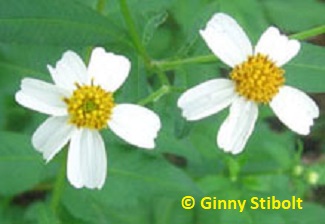 A Plant by any common name...
A Plant by any common name...
by Ginny Stibolt
Most folks who work with plants have sometimes been frustrated
with common names. Yes, they are easy to remember and pronounce,
but there are no hard and fast rules governing them. One plant
might be known by several common names depending upon regional
traditions and personal favorites.
For instance, when I wrote about beggarticks
last year, a reader insisted that they were Spanish needles, not
beggarticks. I could choose which common name to use because I
liked the play on words, "No need to Beg for beggarticks." They
are also known as, Spanish needles, shepherd's needles, butterfly
needles, hairy beggarticks, beggar's-ticks, stick-tights, and
more. And, there are completely different plants that are referred
to using these same names or ones that are confusingly close such
as tickseed that normally refers to a coreopsis. Fortunately,
the reader, no matter what region or country she lived in, could
figure out which plant I was talking about because I also identified
it as, Bidens alba.
Classification of Plants
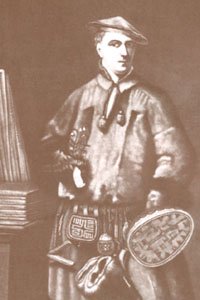 Modern plant taxonomy
started in 1753, when Carl Linnaeus published Species Plantarum.
He devised a system where the first word in the "scientific" name
is capitalized and refers to the genus. The second word refers
to the species and is not capitalized, even if the name refers
to a proper noun like Woodwardia virginica, Virginia chain
fern. Modern plant taxonomy
started in 1753, when Carl Linnaeus published Species Plantarum.
He devised a system where the first word in the "scientific" name
is capitalized and refers to the genus. The second word refers
to the species and is not capitalized, even if the name refers
to a proper noun like Woodwardia virginica, Virginia chain
fern.
The scientific naming of cultivars can use two names after the
genus name or use an "x" between the genus and the hybrid name.
It may be a natural hybrid between two species or it might have
been bred for some special characteristics. For instance, the
Egyptian walking onion is known as Allium cepa proliferum
or Allium x proliferum. The walking onions are prolific
as their varietal name indicates. There are also horticultural
names such as Magnolia grandiflora "Little Gem."
Some plant breeders have trade marked names through the patent
office. I won't go into more detail here on the naming of hybrids,
cultivars, varieties as it gets complex and not everyone agrees.
While the idea of using Latin or Latinized binomials was not new, Linnaeus was the first to systematically apply them to every
plant he saw. He made several plant collecting trips throughout Europe, and he had students and many other botanists (including
William Bartram who tromped through our local habitat) collecting plants from far-flung sections of the globe.
Most of Linnaeus's work was accomplished using one or two dried specimens. He would then mark which specimen he used and that
is considered the "type" specimen, but it did not have to be a typical or average representative of that species.
Sometimes Linnaeus named plants after people. The genus Commelina,
was named after three Dutch botanists in the Commelijn family.
Two of them (an uncle and nephew: Jan and Caspar) were productive
botanists who were widely published, while the third died at a
young age. The three petals of this New World genus usually have
two showy petals and one smaller petal, symbolizing the two productive
botanists and the other one who was not.
Whenever you see "L." following the Latin binomial, Linnaeus was the
first to name it. If there are other letters following his initial,
then other botanists have renamed or reclassified the plant, but
even today, there are thousands of plants that still carry the
names originally devised by Linnaeus.
His methods were quite controversial in his day because his classification
groups were based on the sexual parts of the flowers. Linnaeus
was aware that this was an artificial classification method, but
it allowed botanists to easily determine which plant was which.
Linnaeus never developed the concept of families, but later botanists
created family groupings for plants to show relationships outside
of the genus. For the most part this method of grouping flowering
plants has been held up through all these years, even though this
method of classification produces some unlikely-looking relatives
such as placing Spanish moss (Tillandsia usneoides) in
the pineapple family (Bromeliaceae). If you think about Spanish
moss being an epiphyte (air plant) as are most of the bromeliads,
then you might see the vegetative similarities, though. Today's
botanists may also study plants' DNA and other chemistry to look
for similarities in the genetics to better group related plants.
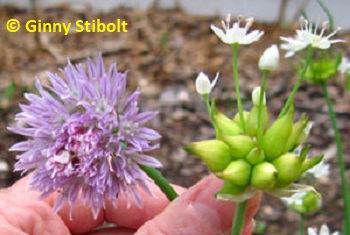 Some onions as examples Some onions as examples
At first glance it may be difficult to see the family relationship
between chives (Allium schoenoprasum) with its spherical
head of lavender flowers and meadow garlic (A.
canadensis) with its bunch of bulblets and a few white
flowers on long stalks. The leaves are different: chives leaves
are round and hollow, while the garlic has flat, strap-like leaves.
So how can you conclude, other than their odor and/or taste, that
they might be related?
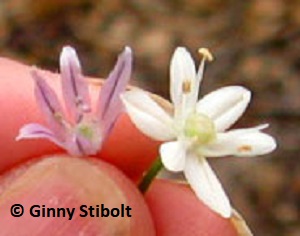 Using the Linnaean system, the vegetative
parts don't matter–it's all in the flowers. Comparing the individual
flowers: they both have six tepals (The term "tepal" is used in
this case when the three inner petals look the same as the three
outer sepals.), six stamens (the male parts) on long stalks, and
an ovary (the female part) divided into thirds. Onions were assigned
to their own family, Alliaceae, in the late 1700s. Later taxonomists
grouped the onions into the lily family, Liliaceae, because all
the members also have six tepals, etc., but most of today's taxonomists
place onions in their own family again. Even though the parts
of the flowers are similar to lilies, members of the onion family
have true bulbs and most produce odorous fumes when cut. True
lilies don't have the odors or bulbs–they usually have corms or
tubers. Using the Linnaean system, the vegetative
parts don't matter–it's all in the flowers. Comparing the individual
flowers: they both have six tepals (The term "tepal" is used in
this case when the three inner petals look the same as the three
outer sepals.), six stamens (the male parts) on long stalks, and
an ovary (the female part) divided into thirds. Onions were assigned
to their own family, Alliaceae, in the late 1700s. Later taxonomists
grouped the onions into the lily family, Liliaceae, because all
the members also have six tepals, etc., but most of today's taxonomists
place onions in their own family again. Even though the parts
of the flowers are similar to lilies, members of the onion family
have true bulbs and most produce odorous fumes when cut. True
lilies don't have the odors or bulbs–they usually have corms or
tubers.
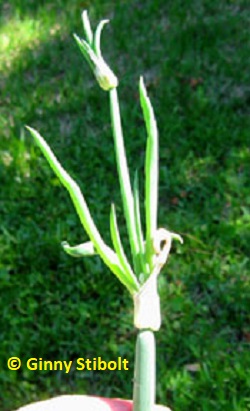 Onions and garlic have
been under cultivation for so long, (approximately 5,000 years)
that the typical onion (A. cepa) and the typical garlic
(A. sativum) are not known in the wild. I purchased some
Egyptian walking onion sets two years ago and we've been enjoying
these perennial onions both as greens and small bulbs. In two
years, I have not seen any flowers, but only the heads with bulblets.
If a flower is ever produced though, I know it will have 6 tepals,
6 stamens, and a 3-parted ovary. Onions and garlic have
been under cultivation for so long, (approximately 5,000 years)
that the typical onion (A. cepa) and the typical garlic
(A. sativum) are not known in the wild. I purchased some
Egyptian walking onion sets two years ago and we've been enjoying
these perennial onions both as greens and small bulbs. In two
years, I have not seen any flowers, but only the heads with bulblets.
If a flower is ever produced though, I know it will have 6 tepals,
6 stamens, and a 3-parted ovary.
Why are they called Egyptian walking onions? Most botanists agree that onions came under cultivation in Egypt. And for this
particular cultivar, as the bulblets expand in the flower head shown in this photo, the stem on which they are borne falls over,
the new bulbs take root, and the onion then begins to "walk" across the garden. Common names also have interesting stories. I've
planted these perennial onions at the edge of a bed, so as I work through the crop rotations each season, the walking onion area
remains undisturbed.
Common vs. scientific names
The scientific names are important to gardeners because they identify
a plant, even if it's a cultivar. So the next time you see a Latinized
binomial associated with a plant, take note of it and write it
down for future reference. Otherwise, how will you know what works,
and what doesn't, in your gardens and how will you make decisions
about future plantings? We should cheer Linnaeus for his industriousness,
thoroughness, and his methodology–he's made gardening easier for
us, even though we might protest some of those long, unpronounceable
names.
Resources:
- For more details on Linnaeus:
www.ucmp.berkeley.edu/history/linnaeus.html.
- I've written about our onions before in
The Skinny on Onions where I discussed long-day and short
day onions and our experiences with them here in Florida.
|


 A Plant by any common name...
A Plant by any common name... Modern plant taxonomy
started in 1753, when Carl Linnaeus published Species Plantarum.
He devised a system where the first word in the "scientific" name
is capitalized and refers to the genus. The second word refers
to the species and is not capitalized, even if the name refers
to a proper noun like Woodwardia virginica, Virginia chain
fern.
Modern plant taxonomy
started in 1753, when Carl Linnaeus published Species Plantarum.
He devised a system where the first word in the "scientific" name
is capitalized and refers to the genus. The second word refers
to the species and is not capitalized, even if the name refers
to a proper noun like Woodwardia virginica, Virginia chain
fern.  Some onions as examples
Some onions as examples Using the Linnaean system, the vegetative
parts don't matter–it's all in the flowers. Comparing the individual
flowers: they both have six tepals (The term "tepal" is used in
this case when the three inner petals look the same as the three
outer sepals.), six stamens (the male parts) on long stalks, and
an ovary (the female part) divided into thirds. Onions were assigned
to their own family, Alliaceae, in the late 1700s. Later taxonomists
grouped the onions into the lily family, Liliaceae, because all
the members also have six tepals, etc., but most of today's taxonomists
place onions in their own family again. Even though the parts
of the flowers are similar to lilies, members of the onion family
have true bulbs and most produce odorous fumes when cut. True
lilies don't have the odors or bulbs–they usually have corms or
tubers.
Using the Linnaean system, the vegetative
parts don't matter–it's all in the flowers. Comparing the individual
flowers: they both have six tepals (The term "tepal" is used in
this case when the three inner petals look the same as the three
outer sepals.), six stamens (the male parts) on long stalks, and
an ovary (the female part) divided into thirds. Onions were assigned
to their own family, Alliaceae, in the late 1700s. Later taxonomists
grouped the onions into the lily family, Liliaceae, because all
the members also have six tepals, etc., but most of today's taxonomists
place onions in their own family again. Even though the parts
of the flowers are similar to lilies, members of the onion family
have true bulbs and most produce odorous fumes when cut. True
lilies don't have the odors or bulbs–they usually have corms or
tubers. Onions and garlic have
been under cultivation for so long, (approximately 5,000 years)
that the typical onion (A. cepa) and the typical garlic
(A. sativum) are not known in the wild. I purchased some
Egyptian walking onion sets two years ago and we've been enjoying
these perennial onions both as greens and small bulbs. In two
years, I have not seen any flowers, but only the heads with bulblets.
If a flower is ever produced though, I know it will have 6 tepals,
6 stamens, and a 3-parted ovary.
Onions and garlic have
been under cultivation for so long, (approximately 5,000 years)
that the typical onion (A. cepa) and the typical garlic
(A. sativum) are not known in the wild. I purchased some
Egyptian walking onion sets two years ago and we've been enjoying
these perennial onions both as greens and small bulbs. In two
years, I have not seen any flowers, but only the heads with bulblets.
If a flower is ever produced though, I know it will have 6 tepals,
6 stamens, and a 3-parted ovary.